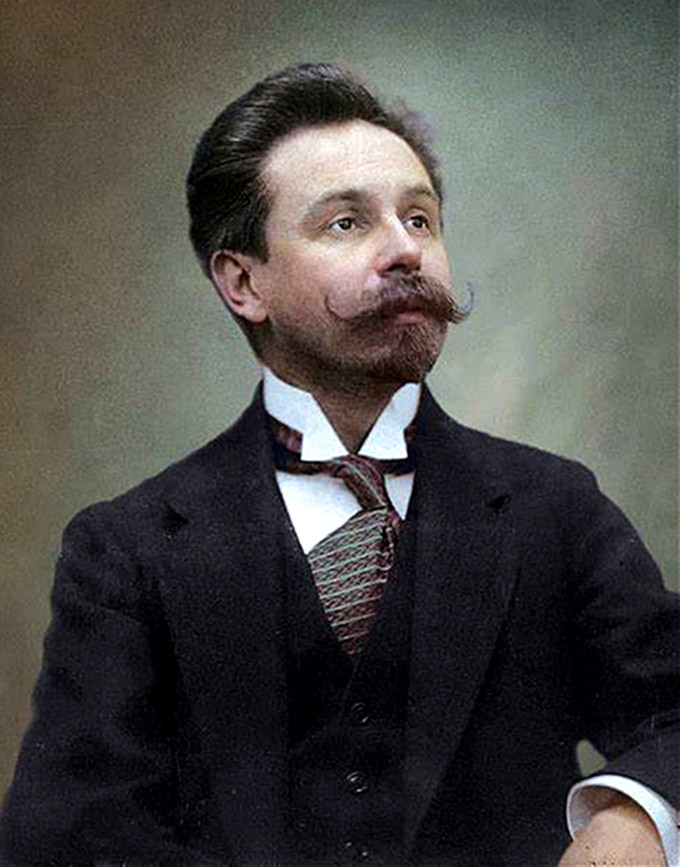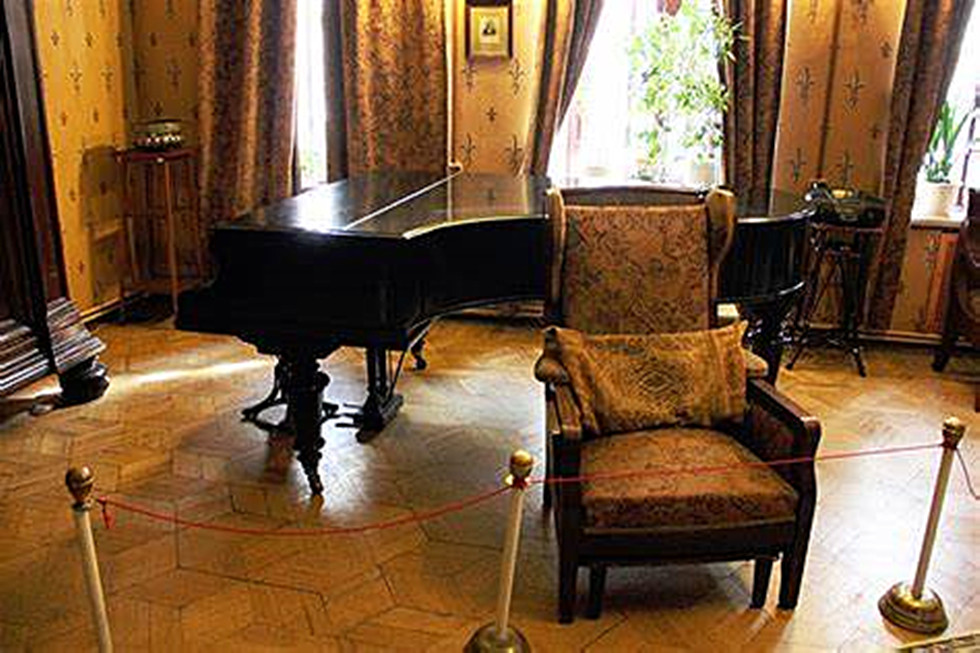| |
| |
 |
|
| |
田润德 编译
文/图 2020-10-23 19:36 |
|
| |
|
|
|
|
| |
 |
|
|
|
| |
亚历山大・斯克里亚宾(Alexander Scriabin,1872-1915) |
|
|
|
| |
|
|
| |
特里福诺夫钢琴 斯克里亚宾-f小调钢琴协奏曲,作品20 |
|
|
|
| |
Trifonov Piano Piece - Scriabin - F Minor Piano Concerto,
Op. 20
|
|
|
|
| |
|
|
|
|
| |
音乐历史上的今天
1897年10月23日,25岁的斯克里亚宾在敖德萨表演了自己的《钢琴协奏曲》。
亚历山大・斯克里亚宾(Alexander
Scriabin,1872-1915)俄罗斯作曲家,钢琴家,神秘主义者。出生在莫斯科的一个贵族家庭。他的母亲在他1岁的时候患肺结核不幸去世。他的父亲因公远赴土耳其,把尚在襁褓之中的斯克里亚宾留给了他的祖母和他父亲的姑妈。早年在军事学院受训,不久就抛弃军人事业,改学音乐。他先跟随尼古拉·兹维列夫学习钢琴,当时拉赫玛尼诺夫也是兹维列夫的学生。后进入莫斯科音乐学院,随瓦西里·伊里奇·萨夫诺夫学习钢琴,随安东·阿连斯基以及谢尔盖·塔涅耶夫学习作曲和乐理。早期的斯克里亚宾对尼采的超人理论很感兴趣,后期又转向通神论,他的音乐作品和音乐观念深受这两者的影响。定居布鲁塞尔期间,开始关注代尔维尔的神智学者运动,去世前一直在策划一个多媒体作品“天启秘境”,并准备在喜马拉雅山上表演,认为这样可以开启世界末日。忧郁症困扰了斯克里亚宾一生,最终他在莫斯科去世,死因是割破嘴唇的伤口导致了败血病。这位伟大的音乐家短暂的生命只在人世间停留了四十三年,但他留给后人的音乐财富却是永存的。
今日视频:1、特里福诺夫演奏斯克里亚宾《f小调钢琴协奏曲》作品20;2、【曲谱同步】斯克里亚宾钢琴协奏曲 第二乐章;3、斯克里亚宾纪录片《朝向光明》。 |
|
|
|
| |
 |
|
| |
亚历山大・斯克里亚宾(Alexander Scriabin,1872-1915) |
|
|
|
| |
 |
|
| |
年轻的亚历山大·斯克里亚宾 |
|
|
|
| |
January: Alexander
Scriabin Was Born |
|
|
|
| |
1872年1月6日:亚历山大·斯克里亚宾诞生了
On This Day
6 January: Alexander Scriabin Was Born
当亚历山大·斯克里亚宾被问及自己的出身时,他自豪地宣称:“我来自一个贵族且军人出身的家庭。”他的家族渊源可以追溯到 13
世纪,当时俄罗斯处于鞑靼人的统治之下。这个家族的名字本身可能源自“skriba”或“sribe”。到了 16
世纪,斯克里亚宾家族离开了尼什尼-诺夫哥罗德附近的故乡,迁往莫斯科。他们忽视了家乡的经济来源,却被大城市的诱惑所吸引,尽管他们的资金耗尽了,但他们仍被视为上层阶级。后来他们投身于军队的职业,到了
18
世纪,有记载称有一位名叫斯克里亚宾的人担任了驻瑞士大使,宫廷史册中也列出了某位名叫斯克里亚宾的将军。这位作曲家的祖父曾被授予圣乔治勋章,并在沙皇炮兵部队中晋升为上校。他的儿子尼古拉,即作曲家的父亲,是第一个打破军事灌输、在莫斯科大学学习法学的军人后代。21
岁时,他在乡间度假期间遇到了音乐会钢琴家柳博娃·彼得罗夫娜·谢蒂尼娜,并坠入爱河。
柳博娃·彼得罗夫娜·谢蒂尼娜是彼得堡郊外一家国家装饰性瓷器厂厂长的女儿。1867
年,她毕业于彼得堡音乐学院,并获得“大金质奖章”以及“自由艺术家”文凭。据一位传记作者所述,她称安东·鲁宾斯坦为“小爸爸”,而他也同样亲切地回应道“小女儿”。她曾师从著名钢琴家西奥多·莱谢蒂茨基,并且他评价她“在女士当中是最出色的”。显然,柴可夫斯基曾说过:“那个谢蒂尼娜姑娘是一位真正的演奏大师,但遗憾的是,她的身体耐力使她无法从事广泛的演艺生涯。”尼古拉和柳博娃于
1870
年秋天结婚。尼古拉开始从事律师工作,而他的妻子则继续她的音乐会事业。在怀孕七个月时,她举办了一场完整的独奏音乐会,演奏了斯卡拉蒂、肖邦、莱谢蒂茨基、舒曼、李斯特以及她自己的《谐谑曲》的作品。在孩子出生前五天,她还举办了一场独奏音乐会,并且病情严重恶化。斯克里亚宾后来写道:“我于
1871 年 12 月 25 日(1872 年 1 月 6
日)出生——采用旧的历法系统,标志着从儒略历到格里高利历的转换。”我可以告诉你的具体时间大概是在中午到下午一点之间。至于地点,是莫斯科。
斯克里亚宾的童年:“两位祖母和一位姑姑。”
Scriabin’s Childhood: “two grandmothers and an aunt.”
8斯克里亚宾的贝希斯坦钢琴
Scriabin’s Bechstein piano
这个婴儿被取名为亚历山大,他的父姓自然就是尼古拉耶维奇,取自他的父亲。亚历山大出生仅十天后,医生就诊断出他的母亲患有严重的肺部感染。尽管她的病情奇迹般地有所好转,但医生建议尼古拉带着他的妻子去欧洲,去气候更温暖的地方。这对夫妇前往了达尔马提亚山脉边缘的阿科镇,那里位于加尔达湖畔。但柳博娃·彼得罗夫娜在
23
岁时去世了,并被安葬在阿科镇。尼古拉回到了莫斯科,他的妹妹柳博娃·亚历山德罗夫娜在她的回忆录中写道:“我对舒林卡(亚历山大)的深情愈发深厚。实际上,我对其他家庭成员的全部爱都凝聚到了他身上。我甚至忘记了自己还年轻,还能够拥有自己的孩子。每当有人提出结婚的提议时,我只需看看那个婴儿,就会意识到自己将与他分离。我无法面对这样的孤独,尽管未来看起来可能很美好。”反过来,亚历山大描述了他的童年记忆为“两位祖母和一位姑姑”。
斯克里亚宾的姑妈:柳博娃·阿列克谢罗娃
Scriabin’s Aunt: Lyubov Alexandrovna
一位传记作者将斯克里亚宾的童年描述为:“在一个柔和而女性化的氛围中度过的,这个氛围存在于昔日的古老父权社会之中。”而对于其他评论家来说,“斯克里亚宾的父权社会已经转变为一种极其强大的母权社会。”小舒林卡生活在一群溺爱她的女性中间,被悉心且谨慎地照顾着,出生时只穿衬衫,而且长时间穿着棉质被子度过了不适合的年龄阶段。”柳博夫·亚历山德罗夫娜阿姨是一位业余钢琴家,她记录了亚历山大早年的经历。“当她弹钢琴时,小舒林卡躺在她的怀里或在踏板旁的枕头上。”如果他在育儿室里哭闹,就会被带到钢琴旁让他平静下来。正如她在回忆录中所写:“舒林卡自出生起就对音乐充满热爱。他对钢琴有着如此温柔的情感,仿佛觉得它也是有生命的。”斯克里亚宾五岁时就能用两只手弹奏钢琴,并且能够复述从路过的小提琴手那里听到的曲调。他的阿姨带他去莫斯科大剧院观看意大利歌剧的音乐会,而“他明亮的眼睛追随乐队而非歌手。音乐响起的那一刻,他的脸颊就会泛红。”不久之后,舒里卡开始制作玩具钢琴,并开始创作一些小短剧。他的剧本总是以诗的形式呈现,情节总是悲剧性的,且分为五幕。“有时情节还相当血腥,以至于到了第三幕,所有角色都会相继死去。”年轻的舒里卡是个非常严肃的孩子;“他从不笑也不玩游戏,很明显,音乐是他唯一的热爱。” |
|
|
|
| |
 |
|
|
|
| |
January: Alexander
Scriabin Was Born |
|
|
|
| |
年轻的亚历山大·斯克里亚宾和他的父亲 |
|
|
|
| |
When Alexander
Scriabin was asked about his origins, he proudly proclaimed, “I come
from a noble and military family.” His family ancestry can be traced
back to the thirteenth century when Russia was under Tatar rule. The
name itself is set to derive from ‘skriba’ or ‘sribe.” By the sixteenth
century, the Scriabin’s left their native place near Nishny-Novgorod and
relocated to Moscow. Neglecting their sources of country income they
enjoyed the lures of the big city, and although their money ran out,
they were considered upper class. In time they turned to the profession
offered by the military, and “in the eighteenth century there is a
mention of a Scriabin as the Ambassador to Switzerland, and the court
annals list a certain General Scriabin. The composer’s grandfather had
been knighted with the Order of St. George and attained the rank of
Colonel in the Tsar’s Artillery. His son Nikolai, the composer’s father,
was the first son to brake military indoctrination and study
jurisprudence at Moscow University. At the age of 21, while taking a
summer holiday in the countryside, he met the concert pianist Lyubov
Petrovna Schetinina, and he fell in love. |
|
|
|
| |
 |
|
| |
|
亚历山大・斯克里亚宾(Alexander Scriabin)唱片:霍洛维茨演奏斯克里亚宾的C小调练习曲
(1986年莫斯科钢琴独奏会) |
|
Alexander Scriabin's Record: Horowitz Plays Scriabin's C Minor
Etude |
|
|
|
|
| |
神秘的斯克里亚宾《升f小调钢琴协奏曲》第二乐章 |
|
|
|
| |
斯克里亚宾《升f小调钢琴协奏曲》作品20的第二乐章,确实带有一种宁静、幻想且略带神秘的气质。这种“神神秘秘”的感觉,并非空穴来风,它源于乐章独特的音乐构思和斯克里亚宾早期的美学追求。
乐章的音乐特征
第二乐章在音乐上主要有以下特点,共同营造出你感受到的那种神秘氛围:
结构与主题:
这个乐章采用变奏曲式 。音乐开始于一个由加弱音器的弦乐奏出的、带有民歌般淳朴风味的主题
。斯克里亚宾本人认为F大调是一种“明亮的蓝色”的神秘调性,这个乐章正是以此调开始 。
氛围营造:
不同的变奏段落塑造了多样的意境。例如,第一变奏中钢琴用琶音为管弦乐的主题伴奏,音域宽广 ;第二变奏速度较快,带有谐谑曲的性质
;而第三变奏则是一个缓慢的葬礼进行曲 ,旋律移到钢琴的低音区,与弦乐呼应
,带来了肃穆甚至阴郁的色彩。这种情绪的转换和对比,增添了音乐的超凡脱俗感。
“神秘”的源头:
这种神秘感并非其后期作品中那种哲学化的神秘主义。这个乐章更侧重于描绘性的幻想,尤其是对“海”的意象的刻画。有研究指出,这首协奏曲的创作时期,斯克里亚宾也对“海的幻想”这类主题感兴趣
。音乐中试图捕捉的,可能是月色下宁静而苍茫的大海,也可能是其汹涌澎湃的不同侧面 。
在作曲家创作生涯中的位置
理解这首协奏曲的关键在于,它是斯克里亚宾24岁时的早期作品 。
浪漫主义传统:此时的他,深受肖邦的影响 ,音乐语言优美抒情,遵循着浪漫主义的传统,尚未发展出他后期那些颠覆性的个人风格。
个人风格的萌芽:尽管如此,我们依然能从中窥见他未来风格的些许端倪。比如,他对复杂节奏型的偏好 ,以及频繁的强弱力度对比
,都已经开始显现。可以说,这个乐章里的“神秘”,更像是一种诗意的、充满想象力的温情和冲动 ,是其独特艺术气质的初显。
聆听与欣赏指南
若要更好地领略这个乐章的魅力,你可以关注以下几点:
关注“变奏”的巧妙:留意主题在五次变奏中,如何通过旋律、速度、音色和伴奏织体的变化,发展出性格各异的表情 。
品味钢琴与乐队的对话:钢琴并非始终占据主导,它时而为乐队提供晶莹剔透的装饰 ,时而与木管乐器(如单簧管)进行对位交织
,这种角色转换非常精妙。
理解标题内涵:如果联想到“大海”的意象 ,或许能帮助你更好地进入音乐所描绘的变幻不定的意境。
总而言之,斯克里亚宾钢琴协奏曲第二乐章的“神秘”,更多是其早期创作中一种诗意的、描绘性的幻想气质。它扎根于浪漫传统,又隐隐透出作曲家未来将探索的、属于他自己的声音世界。
希望这些帮助你更好地理解这首迷人的作品。如果你对斯克里亚宾中期或晚期更具神秘主义色彩的作品(例如他的第四或第五奏鸣曲)感兴趣,我很乐意为你提供进一步的介绍。——莫扎特之旅 |
|
|
|
| |
 |
|
| |
1909
年的一幅俄罗斯作曲家亚历山大·斯克里亚宾及其妻子塔蒂亚娜·施洛泽尔的画像,突显了他们之间在个人和文化层面的深厚关系。斯克里亚宾以其在音乐和哲学方面的贡献而闻名,他与施洛泽尔一同出现在画中,捕捉到了
20 世纪初俄罗斯知识界和艺术界的精英群体的一个瞬间。 |
|
|
|
| |
A 1909 portrait of Russian
composer Alexander Scriabin and his wife, Tatiana Schloezer, highlights
their significant relationship in both personal and cultural terms.
Scriabin, known for his contributions to music and philosophy, is
depicted alongside Schloezer, capturing a moment of the early 20th
century Russian intellectual and artistic elite. |
|
|
|
| |
The second
movement of Scriabin's Piano Concerto in F-sharp Major, Op. 20, indeed
has a serene, imaginative, and slightly mysterious quality. This
"mysterious" feeling is not an arbitrary notion; it stems from the
unique musical conception of the movement and Scriabin's early aesthetic
pursuits. Musical characteristics of the movement The second movement
has the following musical features, which together create the mysterious
atmosphere you perceive: Structure and theme: This movement adopts a
variation form. The music begins with a theme played by muted strings,
with a folk-like simplicity. Scriabin himself considered F major to be a
mysterious tonality of "bright blue", and this movement begins in this
key. Atmosphere creation: Different variations shape diverse moods. For
example, in the first variation, the piano accompanies the orchestral
theme with arpeggios, with a wide range; the second variation is
fast-paced and has the nature of a scherzo; while the third variation is
a slow funeral march, with the melody moving to the piano's lower
register and echoing with the strings, bringing a solemn and even gloomy
color. This transition and contrast of emotions add to the transcendent
quality of the music. "The source of mystery": This mystery is not the
philosophical mysticism found in his later works. This movement is more
focused on descriptive fantasy, especially the depiction of the "sea"
imagery. Some studies suggest that during the creation of this concerto,
Scriabin was also interested in themes like "sea fantasies". What the
music attempts to capture might be the serene and vast sea under the
moonlight, or perhaps its turbulent and different aspects. In the
composer's career, this movement holds a position: Understanding this
concerto lies in the fact that it is an early work by Scriabin at the
age of 24. Romantic tradition: At this time, he was deeply influenced by
Chopin, with beautiful and expressive musical language, following the
Romantic tradition, and had not yet developed his later revolutionary
personal style. The budding of personal style: Nevertheless, we can
still glimpse some hints of his future style from it. For instance, his
preference for complex rhythmic patterns and frequent contrast of strong
and weak dynamics have already begun to emerge. It can be said that the
"mystery" in this movement is more like a poetic, imaginative, tender
and impulsive quality, marking the initial manifestation of his unique
artistic temperament. Listening and appreciation guide: To better
appreciate the charm of this movement, you can pay attention to the
following points: Pay attention to the ingenious "variations": Notice
how the theme, through changes in melody, tempo, timbre and
accompaniment texture, develops into various expressions with distinct
personalities. Appreciate the dialogue between the piano and the
orchestra: The piano does not always occupy the dominant position; it
sometimes provides transparent embellishments for the orchestra, and
sometimes interweaves with woodwind instruments (such as the clarinet),
this role transformation is very delicate. Understand the connotation of
the title: If you associate it with the imagery of "sea", it might help
you better enter the ever-changing意境 depicted by the music. In
conclusion, the "mystery" in the second movement of Scriabin's piano
concerto is more of a poetic, descriptive fantasy temperament in his
early works. It is rooted in the Romantic tradition and faintly reveals
the composer's future exploration of his own voice world. I hope these
help you better understand this charming work. If you are interested in
Scriabin's works with more mystical elements during his middle or late
periods (such as his Fourth or Fifth Sonatas), I would be happy to
provide further introduction for you. -- Mozart's Journey |
|
|
|
| |
 |
|
| |
斯克里亚宾在演奏中 |
|
|
|
| |
|
|
|
|
| |
 |
|
|
|
| |
8斯克里亚宾的贝希斯坦钢琴 |
|
|
|
| |
Scriabin’s Bechstein piano |
|
|
|
| |
 |
|
| |
亚历山大・斯克里亚宾(Alexander
Scriabin)在莫斯科的博物馆。 |
|
|
|
| |
 |
|
| |
在喜马拉雅山的一座寺院举办的一场斯克里亚宾生前理想的音乐会 |
|
|
|
| |
A concert that was held in a
monastery in the Himalayas, which was Skriabin's ideal event during his
lifetime |
|
|
|
| |
这个场合恰逢其时,因为就在 100
年前,斯克里亚宾已经成功地进入了更为高深的音乐领域。他的最后一部作品《神秘大作曲》尚未完成,而他为在喜马拉雅山的一座寺院举办一场为期 7
天的、具有综合感官体验的音乐会所制定的大胆计划也遗憾地不得不放弃。这是斯克里亚宾的音乐在喜马拉雅山山麓首次上演,实现了他一个多世纪前构想的最伟大梦想。
这场音乐会于 2015 年 6 月 21
日夏至日举行,这一天意义非凡。太阳一年中的运行轨迹象征着追求觉悟的过程,而夏至日正是这一旅程的最终高潮,它庆祝着光明战胜黑暗以及自我与神的合一——这些主题对于斯卡比安的神秘主义和音乐哲学来说至关重要。 |
|
|
|
| |
 |
|
| |
这场音乐会于 2015 年 6 月 21
日夏至日举行,这一天意义非凡。太阳一年中的运行轨迹象征着追求觉悟的过程,而夏至日正是这一旅程的最终高潮,它庆祝着光明战胜黑暗以及自我与神的合一——这些主题对于斯卡比安的神秘主义和音乐哲学来说至关重要。 |
|
|
|
| |
 |
|
| |
The occasion was
fitting as exactly 100 years before, Scriabin passed on to the finer
realms of harmony. His final opus, Mysterium Magnum, was left
unfinished, and his bold designs of a 7-day long, synaesthetic concert
in a Himalayan monastery sadly had to be abandoned. This was the first
performance of Scriabin’s music ever held at the foothills of the
Himalayas, a realisation of his greatest dream over a century after its
conceptio
The concert took
place on the Summer Solstice, June 21st, 2015—a date rich with meaning.
The progress of the Sun throughout the year symbolises the process of
attaining enlightenment, and Summer Solstice was the final climax of
this journey, celebrating the triumph of Light over darkness and the
union of self with the divine—motifs of paramount importance to
Sciabin’s mystical and musical philosophy. |
|
|
| |
 |
|
|
|
| |
俄罗斯发行的亚历山大・斯克里亚宾纪念邮票 |
|
|
|
| |
The commemorative stamps
issued by Russia in honor of Alexander Scriabin |
|
|
|
| |
Today in Music
History:
On October 24,
1897, at the age of 25, Scriabin performed his "Piano Concerto" in
Odssa.
Alexander
Scriabin (1872-1915) was a Russian composer and pianist, a mystic. He
was born into a noble family in Moscow. His mother died of tuberculosis
when he was one year old. His father, on official business, went to
Turkey and left the still-nursing Scriabin to his grandmother and his
father's aunt. He was trained at a military academy in his early years
and soon abandoned his military career to study music. He first studied
the piano with Nikolai Zverev, who was also Rachmaninoff's teacher at
that time. Later, he entered the Moscow Conservatory and studied the
piano with Vasily Ilyich Safonov, as well as Anton Arinsky and Sergei
Taneyev for composition and music theory. In his early years, Scriabin
was very interested in Nietzsche's Übermensch theory, and later turned
to theosophy. His musical works and musical concepts were deeply
influenced by these two. During his time in Brussels, he began to pay
attention to the spiritualist movement of Delvillier. Before his death,
he was planning a multimedia work called "The Revelation Sanctuary" and
was preparing to perform it on the Himalayas, believing that this could
open the end of the world. Depression plagued Scriabin throughout his
life, and he died in Moscow from a wound on his lip that led to sepsis.
This great musician's short life only lasted for 43 years, but the
musical wealth he left behind is eternal.
Today's video:
1. Tirynov performs Scriabin's "F Minor Piano Concerto" No. 2; 2. [Score
Synchronization] Scriabin's Piano Concerto - Second Movement; 3.
Documentary "Towards Light" by Scriabin. |
|
|
|
| |
|
|
|
|
| |
|
|
| |
【曲谱同步】斯克里亚宾钢琴协奏曲
第二乐章(Feinberg) |
|
|
|
| |
[Score Synchronization]
Scriabin Piano Concerto, Second Movement (Feinberg |
|
|
|
| |
|
|
| |
【斯克里亚宾】纪录片|“朝向光明”
|
|
|
|
| |
【Scriabin】Documentary
| "Towards Light" |
|
|
|
| |
未得原作者编者授权严禁转载www.mt77.com任何内容 |
|
|
|
.png)

